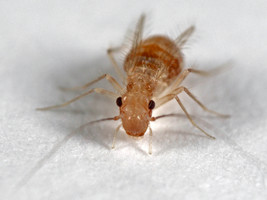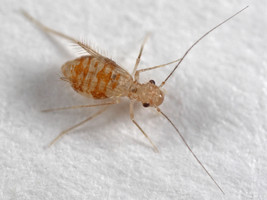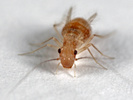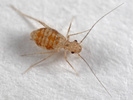Psyllipsocetae
Psyllipsocidae
Emilie Bess and Kevin P. Johnson


This tree diagram shows the relationships between several groups of organisms.
The root of the current tree connects the organisms featured in this tree to their containing group and the rest of the Tree of Life. The basal branching point in the tree represents the ancestor of the other groups in the tree. This ancestor diversified over time into several descendent subgroups, which are represented as internal nodes and terminal taxa to the right.

You can click on the root to travel down the Tree of Life all the way to the root of all Life, and you can click on the names of descendent subgroups to travel up the Tree of Life all the way to individual species.
For more information on ToL tree formatting, please see Interpreting the Tree or Classification. To learn more about phylogenetic trees, please visit our Phylogenetic Biology pages.
close boxIntroduction
The family Psyllipsocidae includes about 50 species in 5 genera distributed worldwide. In North America, six species in four genera are known.Psyllipsocids live in caves, on rock surfaces, in dead leaves, and in buildings. Five of the six North American species have been collected in homes, office buildings, or cellars. These are small bark lice and their bodies may be hairy but do not have scales.
Characteristics
Synapomorphy:
In the female. the spremathecal sac has complex sclerifications at the origin and usually has an accessory vesicle.
General Characters:
Head: Head is long due to long cheeks (gena).
Antennae are long and have more than 20 segments without ringed sculpturing (annulations).
Ocelli are not in groups.
Legs: Tarsi have 3 segments.
Wings: Wings are sometimes hairy but do not have scales.
Forewing: Pterostigma is not thickened.
Vein Sc has a short basal segment that ends at or before wing margin.
Veins CuP and A1 meet on the wing margin forming nodulus.
Hindwing vein A is not branched or has two branches.
Male: Paraproct has an anal spine.
Phallosome is composed of two curved arms that are never fused anteriorly.
Female: Paraproct has an anal spine.
Gonapophyses are reduced:
Dorsal valve is small or absent.
Ventral valve is very small.
External valve is broad and hairy.
Eggs are laid singly and are not covered with silk or debris.
Discussion of Phylogenetic Relationships
The monophyly of family Psyllipsocidae is supported by one character of the female genitalia: the spremathecal sac with complex sclerifications at the origin and usually with an accessory vesicle. Molecular analysis that included the genera Psyllipsocus and Dorypteryx also supports monophyly of the family (18S & Histone3 nDNA, 16S rDNA; Yoshizawa et al. 2006).References
Lienhard, C. and C.N. Smithers. 2002. Psocoptera (Insecta) World Catalogue and Bibliography. Muséum d'Histoire Naturelle, Geneva, Switzerland.
Mockford, E.L. 1993. North American Psocoptera (Insecta). Gainesville, Florida: Sandhill Crane Press.
Smithers, C.N. 1996. Psocoptera. Pp. 1-80, 363-372 (Index) in Wells A. (ed.) Zoological Catalogue of Australia. Vol. 26. Psocoptera, Phthiraptera, Thysanoptera. Melbourne: CSIRO Publishing, Australia.
Smithers, C.N. 1972. The classification and phylogeny of the Psocoptera. Memoirs of the Australian Museum 14: 1–349.
Yoshizawa, K., C. Lienhard, and K.P. Johnson. 2006. Molecular systematics of the suborder Trogiomorpha (Insecta: Psocodea: ‘Psocoptera’). Zoological Journal of the Linnean Society 146: 287–299.
Title Illustrations

| Scientific Name | Dorypteryx longipennis |
|---|---|
| Specimen Condition | Live Specimen |
| Identified By | Charles Lienhard |
| Sex | Female |
| Life Cycle Stage | adult |
| Copyright | © 2009 Albert de Wilde |
About This Page
Emilie Bess

Illinois Natural History Survey, Champaign, Illinois, USA
Kevin P. Johnson

Illinois Natural History Survey, Champaign, Illinois, USA
Correspondence regarding this page should be directed to Emilie Bess at
bess@inhs.uiuc.edu
and Kevin P. Johnson at
kjohnson@inhs.uiuc.edu
Page copyright © 2009 Emilie Bess and Kevin P. Johnson
All Rights Reserved.
- First online 18 March 2009
- Content changed 18 March 2009
Citing this page:
Bess, Emilie and Kevin P. Johnson. 2009. Psyllipsocetae. Psyllipsocidae. Version 18 March 2009 (temporary). http://tolweb.org/Psyllipsocetae/14453/2009.03.18 in The Tree of Life Web Project, http://tolweb.org/









 Go to quick links
Go to quick search
Go to navigation for this section of the ToL site
Go to detailed links for the ToL site
Go to quick links
Go to quick search
Go to navigation for this section of the ToL site
Go to detailed links for the ToL site